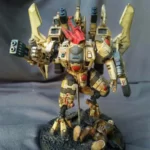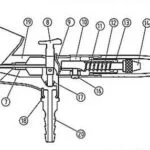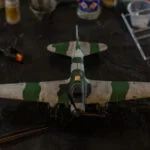Airbrush Vs. Paint Brush for miniatures and models

Do you have a miniature painting project you need to complete? Airbrush and paintbrush are the two most popular painting tools used by many modelers since they work similarly, even producing similar effects.
The main difference between a paintbrush and an airbrush is that with a paintbrush, there won’t be any need for internal blending, making paints come out at full strength, whereas an airbrush layer paints as daubs with continuous strokes.
But even with their similarities, one offers better results than the other. In this article, we discuss the differences between an airbrush and a paintbrush to know which offers better results.
Which will give you better results, airbrush or paint brush
First, let’s consider the merits of each technique to know which gives better results.
Airbrush Pros
- You can easily lay down an even, uniform coat of paint with little effort
- Airbrushing is much faster than using a paintbrush
- You can get hazy, soft effects with an airbrush with proper masking.
- Subtle shading effects are also possible with an airbrush, no matter how thinned the paint is.
Paintbrush Advantages
- Paint brushes are cheap
- Paint brushes are better at wood grain details
- Paint brushes offer detailed painting, so you won’t have to use masking and still get perfect detailing since the brush allows you carefully paint things that are too small to practically mask or are just too tedious to do.
- Paint brushes are versatile, allowing you to do pretty much anything
- Airbrushing does not allow weathering effects, but with a paintbrush, you can precisely apply panel line washes into recessed lines and even use capillary action to distribute the paint if you thin it enough.
The bottom line, airbrushing works well for shading and base coloring, but paint brushes offer better detail painting.
There are many things an airbrush can do better than a paintbrush, like allowing you to execute realistic finish on large and small pieces, but a paintbrush will give better results since it offers fine detailed work and small-scale manipulation control.
The truth is that nothing will get the paint to obey your movements like a brush, especially on the small piece that defines the model. You can’t detail a cockpit or paint a figure’s face with an airbrush.
Read more about painting techniques:
Dry brush Vs Airbrush For Miniatures And Model Kits
LeisureGuided.com
Dry brushing Vs layering (Everything You Need To Know)
Airbrush Vs. spray paint
Paintbrush painting techniques
While brush painting can provide excellent results, the technique is long, making the process much slower. With a paintbrush, you need to provide layers, build up the color, and cover areas.
The most common paintbrush techniques for miniatures and models:
- Base coating: This allows you to apply the basic colors on the model before highlighting intricate details.
- Shading: This technique improves the way light interacts with your model. In this technique, you use washes or shade paints to apply darker paints for shadow effects.
- Layering: paint brushing technique like this helps tidy up any raised panels to strengthen the contrast between the shadows in the recess and intricate parts with fine details.
- Highlighting: Like shading, the highlighting technique imitates the effect of light reflecting off the raised parts of your miniatures so that you draw focus on them.
- Dry brushing: If you have models or miniatures with more natural and rugged textures like fur, highlighting may prove pointless. This technique helps you detail delicate parts with a synthetic bristled brush and a small amount of paint.
Dry brushing Vs layering (Everything You Need To Know)
What results and effects can you get with each technique
Airbrushing allows you to add light strokes, minor details, and blurry edges to offer an impressive realistic finish.
On the other hand, paint brushes offer weathering effects such as washes and dry brushing, which an airbrush cannot replicate without masking.
Which painting technique to use when
To easily replicate a realistic model perfect for display, you need a painting technique offering the right color scheme, as close to the real thing. The painting technique should also offer amazing effects.
The good news is that you can achieve this with the airbrush technique.
If you’re into tabletop gaming like Warhammer, a realistic finish won’t be the topmost priority.
While an airbrush offers realistic appeal, a paintbrush gives you the precise detail weathering effects needed for tabletop gaming.
In summary, airbrushing technique should be used for display purposes, while paint brush is great for gaming miniatures.
Which will be easier to master, airbrush or paint brush
Many modelers find using an airbrush a chore since you need to set it up and pack it away after careful cleaning.
On the other hand, paint brushes only require using the brush and paint to start painting.
Regardless, paint brushes are easier to master since the use and setup stage is straightforward.
Which is better in the long run?
An airbrush and paintbrush offer unique advantages in the long run but consider the following:
| Airbrush | Paintbrush | |
| Mastering the technique | Not so easy | Straightforward |
| Results over time | Will not fade or chip easily | Long-lasting |
| Cost | Expensive | Cheap |
An airbrush can offer the best realism you need from a model, but there are some things an airbrush cannot do.
Some places, you can reach with a paintbrush where it would be impossible to get an airbrush to spray, such as the inside of cockpits or wheel wells. Techniques such as applying washes and dry-brushing rely on a brush to apply the paint in a specific way.
Hence, a paintbrush offers a better advantage in the long run.
Airbrushing will be faster
Speed painting is only possible with an airbrush.
Using a paintbrush can be a slow and tedious task, especially when you leave brush marks and have to add any layer.
An airbrush allows you to cover an entire model in minutes compared to the hours you spend detailing your miniature with a paintbrush.
What do you need for airbrushing vs. brush painting?
Equipment needed for airbrushing
You’ll need essential equipment to airbrush your models.
They include:
- A Compressor or Propeller can: It is the air source that helps with compressed air supply
- Hose: it connects the airbrush to the compressor
- Regulator: allows for control of paint and air supply
- Airbrush: could be double action, single action, siphon feed, or gravity feed airbrush
- Airbrush paint
Equipment needed for brush painting
For paint brushes, you need to have equipment like:
- Brush: different sized brushes for painting, base coating, washing, and dry brushing your models and miniature (preferably, stiff-bristled brushes)
- A palette for thinning paint
- A lid of a plastic container or a ceramic tile (where you can’t get a specialist palette)
Airbrush Requires more cleaning and maintenance
Whether you’re using a brush paint or an airbrush, both require proper cleaning and maintenance to ensure durability and to last longer.
However, this procedure can be tasking and time-consuming when using an airbrush. With an airbrush, every time you change a color you need to clean the airbrush.
Regardless, you should know how to keep them in mint condition for your next usage:
Airbrushes
Airbrush maintenance is essential to prevent the nozzle from clogging. To clean your airbrush, do the following:
- Make sure you clean your airbrush every time you change the color
- Loosen the needle-chucking nut and pull the needle back a little to flush the color.
- Flush the airbrush with water to remove the worst of the color
- Pour an airbrush cleaning fluid into the airbrush cup.
- Use a short-bristled, soft brush, such as a stencil brush to remove any paint inside the cup.
- Flush again with the cleaning fluid but ensure you cover the needle cap with a soft cloth. This technique is called back flushing. It forces air back through the passageways and into the bowl to dislodge any residue.
- Repeat the flushing procedure until the cleaning fluid runs clear
- Spray onto a white cloth or paper towel to test if the airbrush is completely clear
- After flushing the airbrush, clean the needle and needle cap with a damp cloth and cleaning solution
- Unscrew the needle cap and clean the inside with a brush. Clean the nozzle cap if the paint has built up on it, but do not remove the nozzle. Replace the needle cap.
- Tighten the needle-chucking nut firmly with your fingers
- Do not allow the paint to sit in the airbrush for longer than necessary.
Brushes
To clean brushes,
- Get a jar or container.
- Get a good cleaning solution. Water works well for water-based acrylics, but a thinner cleaner or water/alcohol mix gives better results. For oil-based paints, use white spirit or turpentine as a cleaning solution.
- Turn it against the side of a jar at 45 degrees.
- Avoid scrubbing the brush on the bottom of the jar as it may bend the bristles. You may also be welcoming residues settled at the bottom of the jar into the brush.
- Once the paint is removed, finish by swilling the brush in water with a few drops of liquid dishwashing solution. This step helps you remove any final paint residue, whether oil or water-based.
- Dry the brush with a paper towel making sure the bristled hairs form a point
Many painters use both techniques
No matter how different these techniques are, the good news is that you can use both together on a miniature.
Airbrushing gives you control over the smoothness of your color blends. You can blend and layer paints quickly and easily with an airbrush. Then, use a paintbrush to paint intricate details.
If you’re good, You can get the same results with both techniques
Airbrushing is a simple route to getting the perfect color blends for any miniature or scale model kit, while brush painting requires a step-by-step process to get similar details an airbrush produces in minutes.
However, you can easily get the same results with both techniques. For example, both can make shading and layering effects.
Dry-brushing and other weathering effects are more difficult to achieve with an airbrush.
Conclusion – Airbrush Vs PaintBrush
So, what’s better for painting scale models and miniatures, airbrush or paintbrush? Both offer the same results but with brush painting promising more weathering effects.
However, if you plan to display your models, use airbrushing. Gaming kits will do well with the brush painting technique.





